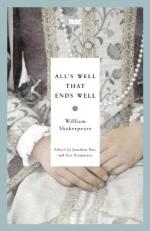|
This section contains 504 words (approx. 2 pages at 400 words per page) |

|
All's Well That Ends Well Summary & Study Guide Description
All's Well That Ends Well Summary & Study Guide includes comprehensive information and analysis to help you understand the book. This study guide contains the following sections:
This detailed literature summary also contains Further Study on All's Well That Ends Well by William Shakespeare.
Scholars generally agree that All's Well That Ends Well was written between 1600 and 1605, although some belIeve that the play is the lost Shakespearean drama tItled Love's Labour Won, which was written before 1598
Most critics believe that Shakespeare's primary Influence in constructing the main plot of the play was Wilham Painters English translation of Giovanni Boccaccio's story of Giletta of Narbonne in his Decameron (1353), titled The Palace of Pleasures (1575). Shakespeare added the characters of Parolles (and the subplot in which Parolles is the main character), the Countess of Rousillon, Lavache, Lafeu, and the second ring at the end of the play. Some commentators have remarked that the uneven nature of the play suggests that it was Written at two different times in Shakespeare's life.
All's Well That Ends Well has often been called one of Shakespeare's "problem plays" or "problem comedies," a category of his work that usually includes Measure for Measure and Troilius and Cressida, because these works often seem more similar in tone and theme to the tragedies Shakespeare was Writing during the same time period than they do to the romantic comedies he wrote in the 1590s. Most critics acknowledge the folktale elements in the play. Some critics condemn the play outright, considering it a comedic failure Others take into account how the play would have been received by Elizabethan audiences and find it successful, despite what might seem to be its oddities to twentieth-century readers. Rarely does a critic praise the play without reservation.
Early critics of the play focused on the incongruous plot elements and the thematic concerns of merit and rank, virtue and honor, and male versus female. More recent critics address these issues, but they focus more attention now on topics such as gender and desire. Helena's sexuality and the reversal of gender roles has generated much discussion, especially as they intertwine with other main conflicts in the play, such as social class, the bed-trick, and marriage. The ending of the play (whether the play does end well, as the title suggests it does) has historically been much-debated and continues to be so in recent Criticism.
The three main characters-Helena, Bertram, and Parolles-have generated a great deal of literary criticism and comment as well. Some critics brand Helena as conniving and obsessive in her love for Bertram, while others find her wholly virtuous and noble in general, critics are united in their displeasure with the character of Bertram, though some Judge him more harshly than others. Some critics find Bertram thoroughly unrepentant and unredeemable at the end of the play, making the ending implausible. Others are more sympathetic toward him, finding him merely immature at the beginning of the play and in need of life experience in order for him to "grow up." Parolles has generated less controversy in terms of the nature of his character (even Parolles himself recognizes his deficiencies and is not ashamed of them), and some critics find the subplot involving Patolles the only thing that saves the play from utter failure
Read more from the Study Guide
|
This section contains 504 words (approx. 2 pages at 400 words per page) |

|



